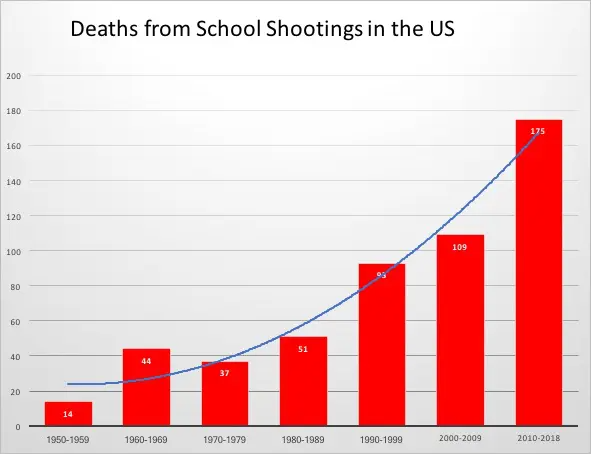
Source of graph: Wikipedia, 2018
Preventing Violence and Helping Children Cope with Trauma
It is with great sorrow that we share our condolences with the families and community of Santa Fe High School. No one can doubt that school shootings are now an epidemic in the U.S., with an average of one school shooting every week this year. In looking at the list of 2018 school shootings, one realizes that these shootings are across a range of States, and each perpetrator seems to have a unique history. It is difficult to identify the specific factors that are common across the shooters, other than they are clearly very angry individuals who have resorted to lethal violence as a resort to cope with their particular feelings and situation.
The national crisis of school shootings has left children, administrators, teachers, parents, and families feeling fearful, helpless, and even terrorized, given the unpredictability of school gun violence. Parents and schools are desperately seeking ways to keep their children and students safe, while providing a healthy and positive environment.
Although one can approach this epidemic in multiple ways, it is important for families, professionals, law-makers, school administrators, and teachers to recognize that prevention is perhaps more effective than intervention in the long-run. It is imperative that we respond to gun violence via a holistic platform and address it as a developmental, mental health, legal, and socio-cultural phenomenon, beginning with interventions in schools and homes at a very early age. There are several possibilities for positive interventions, and here are a few suggestions:
- Early and free parenting programs can be offered at schools, religious centers, and local community organizations. The programs would be developmentally geared to address norms, expectations, parent guidance, and wellness markers for specific age groups, such as infancy, pre-school, elementary, middle school, and high school children.
- Psycho-educational classes can be offered for parents, teachers, administrators, and nurses that focus on a deeper understanding of whole-child development, to include, medical, cognitive, language, motor, socio-emotional, and mental health issues. Providing specific information and training on key mental health red-flags for children and teenagers, such as depression, anxiety, isolation, anger, bullying, impulsivity, etc., will allow early detection and early intervention, which could lead to critical early support and healing.
- Schools need to provide well organized structured systems and venues for teachers to identify, discuss, and refer students who may be at risk for socio-emotional, cognitive, and mental health struggles. Providing sufficient school psychologists, counselors, and small class-room sizes for each school will increase the likelihood of success of these programs.
- Schools and families need to begin structured, informed, and frequent discussions about violence at an early age, so that children learn and recognize how harmful, dangerous, and wrong violence can be.
- Role modeling and teaching positive conflict resolution, negotiation, expression of feelings, empathy, assertiveness, seeking help, and problem solving in a pro-active, deliberate, and daily routine in the classroom and at home can be very powerful in teaching children critical non-violent coping skills.
- Schools can invite parents to allow their children to participate in standardized mental health screening tools. Parents can also ask their pediatricians to implement screening interviews and questionnaires with the family to identify at-risk children.
It is imperative that we begin to invest huge amounts of time and money into our children’s mental health and well being in the hopes of addressing the national crisis of school shootings.
Additionally, we need to continue to provide support for the children who have lost their loved ones, have witnessed the trauma, and those who now live in anxiety and confusion about when and where the next shoot-out is going to be. Children may not feel safe going to school and parents may have tremendous anxiety about if and when their child will return home safely.
My book, Where Did My Friend Go: Helping Children Cope With A Traumatic Death specifically addresses helping young children understand, grieve, and cope with a sudden death. It can be used by schools, parents, caregivers, and professionals as the first step in the healing process.
Parents and schools need to continue to have validating, supportive, and reassuring conversations with their teenagers and children about the loss, grief, and trauma of school shootings. Parents should continue to remind their children that grown-ups are working hard to stop gun violence and keep children safe. Becoming an active participant in your community and school to raise awareness of and develop laws, school safety plans, mental health education and interventions, parent guidance and child development education, and violence prevention programs could be very empowering to you and your child.
It takes a village to create positive change, and we must all join hands to prevent school violence, provide free education and support for parenting, child development, and mental health issues, and continue to help our children cope with the chronic trauma of school shootings.
